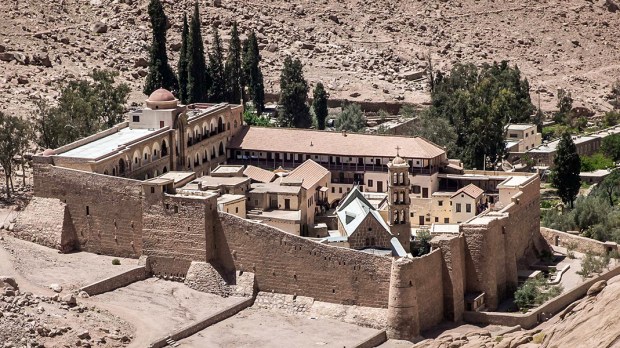These days, archaeological excavations are being conducted not only in the earth but on paper as well.
Or parchment, we should say, in the case of research going on at St. Catherine’s Monastery in Egypt’s Sinai desert.
One recent finding: an ancient medical recipe by Hippocrates, who is considered to be the father of western medicine. It was discovered in one of approximately 160 manuscripts known as palimpsests held at the UNESCO site. The manuscripts have faint scratches and ink tints beneath more recent writing. The older script was probably scraped out by monks between the 8th and 12th centuries so the rare parchments could be reused, according to Tony Kazamias, an adviser to the head of the 1,500-year-old monastery.
Some were written in long-lost languages such as Caucasian Albanian and Christian Palestinian Aramaic, a mix of Syriac and Greek that died out in the 13th century. Some of the earliest versions of the New Testament were written in this language.
The Atlantic described the technology helping to bring these ancient scripts to light:
The researchers photograph each page 12 times while it is illuminated with different-colored visible light, ultraviolet light, and infrared light. Other images are taken with light shining from behind the page or off to one side at an oblique angle, helping to highlight tiny bumps and depressions in the surface. Together, these photographs help reveal the minute traces of ink left on the pages after they were erased or the scratches left by a scribe’s quill. Computer algorithms then analyze and combine the images so the text on top can be separated from the words below.
Three previously unknown Greek medical treatises have also been found, including one that contains the oldest known recipe credited to Hippocrates, the Atlantic reported.
While this research has been going on, the Greek Orthodox monastery, built at the base of Mt. Sinai, has been restoring part of its historic library, which holds around 3,300 manuscripts of mainly Christian texts in Greek, Arabic, Syriac, Georgian, Slavonic, and other languages. Though the restoration work will continue, the monastery held a ceremony in mid-December to reopen the library to the public and to scholars, according to a Voice of America report.
The findings of the ancient texts will also be available online, a move that is being seen as a way to preserve the treasures for posterity, even if they might one day be lost again. That has been a real fear, as there have been threats in recent years from the Islamic State group.
“A big piece of what we are doing is making sure future generations have access to this material despite the geopolitical pressures,” says Todd Grappone, an associate librarian at the University of California, Los Angeles, and a member of the research team.
It wouldn’t be the first time St. Catherine’s preserved precious treasures. Due to its remote location, it was untouched by the iconoclasts during the eighth and ninth centuries. As a result, the monastery possesses the finest and most extensive collection of icons from as early as the sixth century, including the famous Christ Pantacrator.

